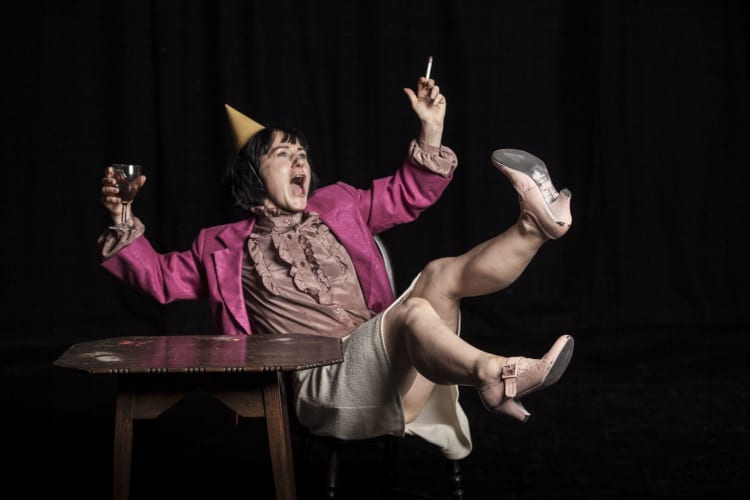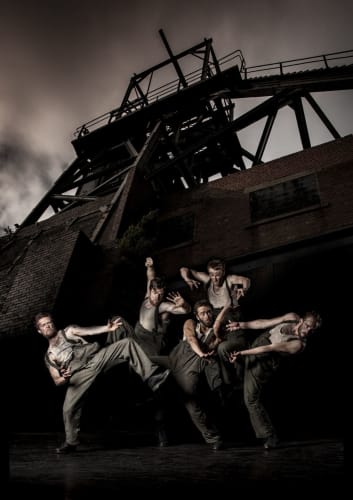Nowhere outside of panto have I heard such hisses and boos during a performance. Towards the end of Gary Clarke’s evocative dance theatre piece responding to the era and atmosphere of the Miners' Strike, a crowd parts to reveal an unmistakeable silhouette: Margaret Thatcher.
It is this figure which draws the ire of the audience; not, I hasten to add, the performer, Eleanor Perry, who steps firmly forward to deliver a remarkable choreography mixing recognisable Thatcherite gestures with extremes of grotesque—and some quite beautiful—contortions.
This is a show which plays upon these kinds of contrasts repeatedly. At its best it conjures spectacularly well the atmospheres, exertions and stresses of the life in the mine.
The production lowers us into this world gently, after a humorous and inventive opening showing us the chaotic choreography of the morning routine. The Miner’s Wife, played by T C Howard, prepares breakfast, then dresses and massages her husband Alistair Goldsmith.
Brief snatches of dialogue, much seemingly improvised, can be heard as the dancers perform their vigorous and playful routines, backed in this opening sequence by a brass quintet drawn from members of Carlton Main Frickley Colliery Band.
This then transitions into a second light-hearted section, introducing the other four male dancers, Nicolas Vendange, James Finnemore, Joss Carter and Connor Quill. The jolly clichés of cheery workers strolling chummily to work are out in force, but into this inconsequential-seeming sequence occasional gestures of protest are incorporated, hinting at the unrest underlying the era.
For the lengthy and physically punishing section of the show in which these men are at work underground, the brass band leaves the stage, replaced by an eerie soundscape of mechanical and subterranean sounds created by Daniel Thomas. This rhythmic and inhuman backing works well along with design by Ryan Dawson Laight and the superlative lighting of Charles Webber, creating a real sense of dimming natural light and confined space despite the dancers’ often remarkably explosive contortions.
It is this sequence that feels like the heart of the show, and Gary Clarke’s choreography explores with variety and passion the parallels between the labour of the miner and the physical exertions of the dancer. These men are actually sweating; their physiques really honed by the genuine effort of the movement vocabulary.
It is not all explosion, though. There’s a fascinating (and again well-lit) moment in which the exhausted dancers lie down with their backs towards the audience, rolling their muscular shoulders and backs to generate strange, rippling, alien shapes and shadows. It’s the simplest choreography but a striking image. This is punctured (literally) by the "1812 Overture" and one dancer inflating a black balloon, signalling a move to a more troubling sequence in which the deleterious effects of the coal dust and other risks of this remote, isolated work are explored.
The final third of the show moves back above ground, after a slightly odd interlude in which the mood is again lightened by a faux-interval (biscuits are handed round and a raffle drawn) and a highly enjoyable disco sequence to the great "Wooly Bully".
If this final sequence, heralding the arrival of Thatcher and the demarcation of the picket line, feels uneven, it’s in part because the politics here are not explored in anywhere near as much detail as the aesthetics of labour in the mines. Gary Clarke states that he doesn’t mean to be provocative or to create a political show, but the cartoon-like nature of the Thatcher we see, and the lack of time dedicated to either side of the dispute, present us with a depiction which leaves little room for nuance or debate, and little doubt of the emotional response intended.
So there is more of interest in the first half, when the show focuses on the work and effort of the miners. But this is an unquestionably beautiful piece throughout. And the underlying seam of political provocation—a dance theatre company staging a piece about a whole industry at threat because of ideologically-driven cuts—remains unmined but unquestionably present, somewhere beneath the surface.


